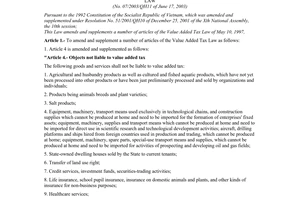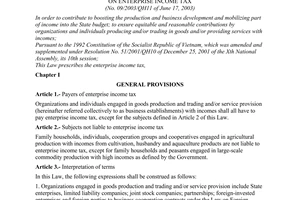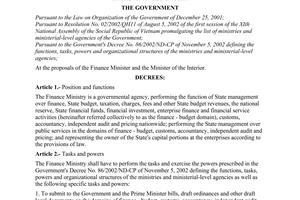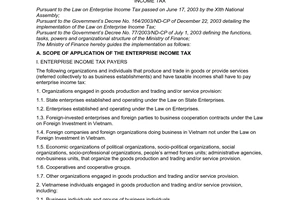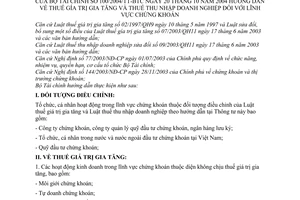Nội dung toàn văn Circular No. 100/2004/TT-BTC of October 20, 2004, guiding value added tax and enterprise income tax applicable to the securities domain
|
THE
MINISTRY OF FINANCE |
OF VIET |
|
No. 100/2004/TT-BTC |
, October 20, 2004 |
CIRCULAR
GUIDING VALUE ADDED TAX AND INCOME TAX APPLICABLE TO THE SECURITIES DOMAIN
Pursuant to May 10, 1997 Law
No. 02/1997/QH9 on Value Added Tax and June 17, 2003 Law No. 07/2003/QH11
Amending and Supplementing a Number of Articles of the Law on Value Added Tax
and the guiding documents;
Pursuant to June 17, 2003 Law No. 09/2003/QH11 on Enterprise Income Tax
(amended) and the guiding documents;
Pursuant to the Government’s Decree No. 77/2003/ND-CP of July 1, 2003 defining
the functions, tasks, powers and organizational structure of the Finance
Ministry;
Pursuant to the Government’s Decree No. 144/2003/ND-CP of November 28, 2003 on
securities and securities market;
The Finance Ministry hereby guides the implementation as follows:
I. SUBJECTS OF REGULATION
Organizations and individuals operating in the securities domain and subject to the regulation by the Value Added Tax Law and the Enterprise Income Tax Law as guided in this Circular include:
- Securities companies, securities investment fund management companies, custody banks;
- Vietnamese and foreign organizations and individuals investing in securities in ;
- Securities investment funds;
II. REGARDING VALUE ADDED TAX
1. Business activities in the securities domain, which are not subject to value added tax, include:
- Securities brokerage;
- Securities dealing;
- Securities investment portfolio management;
- Securities issuance underwriting and agency;
- Financial consultancy and securities investment consultancy provided by securities companies or fund management companies to clients in the fields of securities investment, financial restructuring, separation, division, merger or consolidation of enterprises and assistance to enterprises in securities issuance and listing;
- Securities investment fund management;
- Securities investment fund supervision;
- Securities custody;
- Representation for bond owners;
- Investment activities of securities investment funds.
2. Organizations and individuals conducting securities business activities not subject to value added tax prescribed at Point 1, Section II of this Circular shall not enjoy deduction and reimbursement of input value added tax on goods and services used for such value added tax-free activities.
In cases where value added tax-free activities require value added invoices, the line “selling price” in such invoices shall be inscribed with value added tax-exclusive price, while the lines “tax rate” and “value added tax amount” shall be left unfilled in and crossed out.
III. REGARDING INCOME TAX
1. For securities companies, fund management companies (hereinafter referred collectively to as companies):
1.1. Bases for calculation of enterprises income tax: income tax shall be determined by taxable income in tax calculation period multiplied by (x) tax rates.
1.1.1. Taxable income in tax calculation period shall be determined according to the following formula:
|
Taxable incom in tax calculation period |
= |
Turnover for calculation of incom taxable in tax calculation |
- |
Reasonable expenses in tax calculation period |
+ |
Other taxable incomes |
1.1.1.1. Turnover for calculation of taxable income in tax calculation period consists of charges collected from provision of services to clients and turnover from dealing activities, including:
< p="">< p="">< p="">< p="">< p="">< p="">< p="">< p="">< p="">1.1.1.2. Reasonable expenses which shall be subtracted when determining taxable income in the period are expenses for the provision of services to clients and expenses for dealing activities, including:
< p="">a1/
< p="">- Fixed assets must be used for business activities.
- Fixed assets must fully have invoices, vouchers and other lawful papers proving that they are under ownership of companies.
- Fixed assets must be managed, monitored and accounted in accounting books of companies according to the current management and accounting regimes.
a2/ Levels of fixed asset depreciation into reasonable expenses shall comply with the Finance Minister’s decisions on fixed asset management, use and depreciation regimes.
Companies which apply the method of straight-line depreciation with high economic efficiency shall be entitled to fast depreciation for fast technological renewal, which, however, must not exceed two times the depreciation level by the straight-line method. Fixed assets involved in business activities and eligible for fast depreciation include machinery, equipment, transport means and management tools. When conducting the fast depreciation, companies must ensure that their operations are profitable.
a3/ Fixed assets which have their values fully depreciated but continue to be used in business shall not be depreciated.
< p="">< p="">c1/ Salary payment expenses of companies include salaries, remunerations and/or allowances which must be paid to laborers according to the provisions of the Labor Code and shall be determined as follows:
- For companies being State enterprises: Expenses for salaries which must be paid to laborers shall be determined on the basis of current legal documents guiding the salary, remuneration and allowance regime prescribed by the Labor Code.
- For other companies: Expenses for salaries which must be paid to laborers shall be based on labor contracts or collective labor agreements.
Annually, companies must register their total salary funds with tax offices.
c2/ Expenses for mid-shift meals shall be decided by directors of companies according to companies’ business efficiency but the monthly payment to each laborer must be ensured not to exceed the minimum salary level set by the State for State employees.
< p="">< p="">f/ Expenses being charges for services provided from outside such as: postage, charge for fixed asset maintenance and repair; charge for use of equipment system of the Securities Trading Center; charge paid to supervising or auditing organizations; charge for legal consultancy and compilation of economic contracts; expenses for hiring specialists and charges for other services from outside;
< p="">);
;
);
< p="">< p="">< p="">q/ Expenses for care for, and communication with, investors;
< p="">s/ Expenses for female laborers according to the provisions of the Finance Ministry’s Circular No. 128/2003/TT-BTC of December 22, 2003;
t/ Payment of loan interests at actual interest rates at the time of signing loan contracts, which, however, must not exceed 1.2 times the lending interest rate at the same time of commercial banks having transactions with companies;
< p="">The deduction level shall be calculated on the basis of aggregating the reserve level for price decrease of each type of securities according to the following formula:
|
Reserve level for securities price decrease for the plan year |
= |
Volume of securities with decreased on December 31 of the reporting year |
x |
Securities prices accounted in accounting books |
x |
Closing price of (or the nearest closing price if December 31 is not a trading day) |
< p="">< p="">1.1.1.3. The following amounts shall not be accounted into reasonable expenses:
< p="">< p="">< p="">< p="">< p="">< p="">< p="">< p="">1.1.1.4. Other taxable incomes:
Other taxable incomes in the tax calculation period include: deposit interests; asset rentals; proceeds from asset liquidation, transfer or sale after subtracting their remaining values and expenses related to asset liquidation, transfer or sale; collected fines for breaches of economic contracts after offsetting paid fines for breaches of economic contracts; debts which have been written off in accounting books but are now recovered; payable debts with unidentified creditors; refunded reserves, which have been already set aside but neither used nor used up, and other taxable incomes.
1.1.1.5. Tax calculation period and loss transfer duration:
Tax calculation period is determined according to calendar year. In cases where companies apply other fiscal years than the calendar year, the tax calculation period shall be determined according to the applied fiscal year. The first tax calculation period for newly-established companies and the last tax calculation period for companies subject to transformation of enterprise type, ownership form, merger, separation, division, dissolution or bankruptcy shall be determined in compatibility with the accounting period according to law provisions on accounting.
After determining taxable incomes according to the above-said formula, companies may offset losses transferred from previous tax calculation periods before determining payable enterprise income tax amounts. The duration for loss transfer must not exceed 5 years.
1.1.2. Tax rates:
Securities companies and securities investment fund management companies may apply the enterprise income tax rate of 20% for 10 years after they commence their business operations. Upon the expiry of the duration eligible for the tax rate of 20%, companies must shift to pay enterprise income tax at the tax rate of 28%.
In cases where companies have commenced their business operations and have declared for payment of enterprise income tax at the tax rate of 32% (for enterprises operating under the Domestic Investment Promotion Law) or the tax rate of 25% (for enterprises operating under the Law on Foreign Investment in Vietnam), from the fiscal year of 2004 they may shift to apply the tax rate of 20% for the remaining duration, which shall be equal to (=) the period when the tax rate of 20% is applied minus (-) their operational period.
For example: In 2000, securities company x commenced its operation at its head-office located in city. Until before 2004, the Company had made enterprise income tax declaration and payment at the tax rate of 32%. Since the fiscal year of 2004, the Company has been allowed to shift to the application of the enterprise income tax rate of 20% until the end of the fiscal year of 2009. And from the fiscal year of 2010 on, the Company shall have to apply the tax rate of 28%.
1.2. Tax exemption or reduction duration:
1.2.1. Newly established securities companies and securities investment fund management companies shall enjoy the enterprise income tax exemption for 2 years after their taxable incomes are generated and a 50% reduction of payable tax for subsequent 3 years.
Tax exemption or reduction years shall be determined in compatibility with the tax calculation period. The tax exemption or reduction duration shall be counted continuously from the tax calculation period when companies start generating taxable incomes (before offsetting losses transferred from previous tax calculation periods). In cases where companies, which have operated for less than 12 months, generate taxable incomes right in the first tax calculation period, they may register with tax offices for counting the tax exemption or reduction duration right from such first tax calculation period or from the second tax calculation period.
1.2.2. Companies established before January 1, 2004 which have already enjoyed enterprise income tax exemption or reduction shall continue enjoying it for the full tax exemption or reduction duration prescribed in Item 1.2.1 of this Point.
income tax preferences shall apply only to companies which conduct independent economic accounting, fully observe the accounting, invoice and voucher regime, and have made tax registrations and paid tax according to such registrations.
2. < p="">
2.1. Business organizations conducting independent economic accounting include enterprises of all types, conducting business operations in all domains (except for securities companies and fund management companies), and conducting independent economic accounting, such as State enterprises, limited liability companies, joint-stock companies, partnerships, enterprises operating under the Law on Foreign Investment in Vietnam, economic organizations of political organizations, socio-political organizations or socio-professional organizations investing in securities: securities investment activities of such organizations are considered financial activities, and therefore, incomes from securities investment in the tax calculation period must be aggregated with incomes from business activities of enterprises for calculation of enterprise income tax according to general regulations.
Taxable income from securities investment in the tax calculation period shall be determined equal to total value of securities sold in the period minus (-) total purchase price thereof minus (-) securities purchasing and selling expenses plus (+) bond interests for bond holders. Such taxable income shall not include divided profit portion already levied with enterprise income tax in the previous stage and bond interests collected from tax-free bonds according to law provisions.
2.2. Other organizations (except for those prescribed in Item 2.1 of this Point, securities companies, fund management companies and securities investment funds), including foreign investment funds which only open their bank accounts in Vietnam without making their presence in Vietnam and invest in securities, shall pay presumptive enterprise income tax. Payable tax amounts shall be determined equal to 0.1% of the total value of their stocks sold in each transfer transaction (for investment fund certificates, tax shall be calculated as for stocks, while bonds of all kinds shall not be subject to enterprise income tax when being transferred). Such organizations’ divided profit portions already levied with enterprise income tax in the previous stage and bond interests collected from tax-free bond types according to law provisions shall not be subject to enterprise income tax.
- Mode of collecting and paying presumptive tax shall be as follows:
+ For listed stocks: Securities companies shall have to withhold enterprise income tax and make, on behalf of investing organizations, tax declaration (according to a form promulgated together with this Circular, not printed herein), payment and settlement with tax offices according to the guidance at Point 1, Section IV of this Circular.
- For unlisted stocks:
+ In cases where joint-stock companies authorize securities companies to manage all the lists of shareholders and carry out the procedures for transferring stocks among investors or between companies and investing organizations, the withholding of tax amount and the tax declaration, payment and settlement with tax offices shall also be made as in case of listed stocks.
+ In cases where joint-stock companies do not authorize securities companies to manage their lists of shareholders or manage the stock transfer registration or only authorize the management of part of shareholders’ lists for transfer registration, payment of dividends (for example, in case of management of lists of shareholders outside or far away from companies), such joint-stock companies shall have to withhold tax and make, on behalf of investing organizations, tax declaration (according to a form promulgated together with this Circular, not printed herein), payment and settlement with tax offices according to the guidance at Point 1, Section IV of this Circular.
In cases where securities-investing organizations defined in Items 2.1 and 2.2 of this Point invest in securities through securities investment funds, they shall pay enterprise income tax according to the guidance at Point 3, Section III of this Circular.
3. < p="">
Securities investment funds are not liable to pay enterprise income tax. When securities investment funds divide profits to investors, the divided profit portions of investing organizations (irrespective of domestic or foreign investing organizations) shall be subject to enterprise income tax at the tax rate of 20% (except for divided profit portions already imposed with enterprise income tax in the previous stage and bond interests collected from tax-free bond types according to law provisions).
Securities investment fund management companies shall have to withhold payable enterprise income tax amounts of investing organizations at the tax rate of 20% and make tax declaration (according to a form promulgated together with this Circular, not printed herein), payment and settlement according to the guidance at Point 1, Section IV of this Circular. Particularly, investing organizations defined in Item 2.1, Point 2, Section III of this Circular may choose the mode of tax self-payment by aggregating their incomes from securities investment with their incomes from business activities for tax calculation and payment according to the provisions of the current Enterprise Income Tax Law. Investing organizations shall have to notify the securities investment fund management companies of such tax self-payment so that the corresponding tax amounts shall not be withheld.
For example: In March 2004, Hoang Tien Cement Company invested VND 200 million in a securities investment fund. By December 2005, the securities investment company shall divide profit. Hoang Tien Company is divided VND 10 million, of which VND 2 million are dividends already imposed with enterprise income tax at enterprises in which the fund invests capital. So, of the profit amount of VND 10 million divided to Hoang Tien
< p="">
4. < p="">
Vietnamese and foreign individuals who invest in securities in shall temporarily not have to pay income tax on income amounts being dividends, bond interests, securities purchase/sale differences and other incomes from securities investment according to current regulations.
IV. ORGANIZATION OF IMPLEMENTATION
1. The tax registration, declaration, payment and settlement and the handling of tax-related violations committed by organizations and individuals operating in the securities domain shall comply with the current law provisions on value added tax and enterprise income tax.
Particularly, securities companies, securities investment fund management companies and joint-stock companies, which withhold enterprise income tax amounts and pay tax on behalf of investing organizations, shall make tax declarations and settlements (according to set forms) with the tax offices directly managing them and pay tax into the State Treasury. The tax declaration, payment and settlement shall be made within 30 days after taxable incomes of investing organizations are generated.
2. Securities companies, securities investment fund management companies and joint-stock companies, which withhold tax amounts of investing organizations and make tax declaration and payment on behalf of investors, shall enjoy < span="">equal to 0.8% of the actually collected tax amounts but not exceeding VND 50 million for each time of tax declaration and payment. Such remuneration shall be deducted from collected tax amounts before being remitted into the State budget, and shall be used to cover expenses for tax collection and payment, give rewards to individuals involved in tax collection and payment.
3. This Circular takes effect 15 days after its publication in the Official Gazette.
Any problems < p="">
|
|
FOR THE FINANCE
MINISTER |
|
FORM 01 (Issued
together with the Finance Ministry's Circular |
OF - Freedom - Happiness |
INCOME TAX LIST
(For use by securities companies, fund-managing companies and joint-stock companies that withhold and pay enterprise income tax on behalf of investment organizations having incomes generated from securities investment)
Name of tax-withholding company: …………………………….
Address: …………………………..
Tel.: …………….. Fax: ………………… Email: ………………….
Tax identification number: …………………………………
Deposit account
Total amount of enterprise income tax to be paid on behalf: …………
(< p="">
|
Ordinal number |
Date when taxable income is generated |
Name of investment organization subject to tax withholding |
Address of tax paying organization |
To be- withheld enterprise income tax amount |
Notes |
|
|
|
|
|
|
|
Date:
|
Head of the unit (Signature, full name, stamp) |
Declaration maker (Signature, full name) |
Declaration to be sent to:
- Tax office:
- Address:
Declaration-receiving tax office:
- Date of receipt:
- Recipient: (Signature, full name, position)
This form is made in 2 copies, 1 of them to be sent to the tax office, the other to be kept at the company deducting and paying enterprise income tax on behalf of the investment organization having incomes generated from securities investment.-

